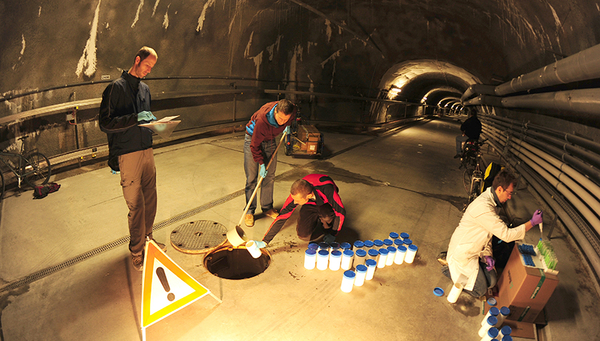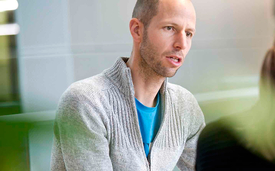Archive detail
Wastewater testing as a potential early warning system for waves of coronavirus
April 3, 2020 |
You were already collecting wastewater samples in Ticino weeks ago – why?
Christoph Ort (environmental engineer): We have many years of experience in the measurement of illicit drugs in wastewater. After all, wastewater doesn’t lie – and it reflects what the public are excreting within the space of a few hours. In the past, this has allowed us to assist epidemiologists and experts in drug abuse prevention by providing new figures. Now there are initial indications from Dutch colleagues (see link at bottom of page) that the SARS-CoV-2 virus, which triggers coronavirus disease 2019 (COVID-19), is also found in wastewater. We’re confident that this will not only be detectable but also quantifiable – or countable, so to speak. In the ideal scenario, this could be used to estimate the number of individuals with the disease. According to current knowledge, we should be able to detect a few diseased individuals among 100,000 healthy people.
How do you obtain the samples?
A previous collaboration meant that we already had contact with the Office of Water Protection and Supply in Ticino. Following our request, they went straight to the operators of wastewater treatment plants and simply asked them to collect samples. As our samples need to be collected in glass bottles and kept cold at all times, we picked them up ourselves rather than putting the staff of the wastewater treatment plants to the trouble of sending them by post or courier. That was still easy to do in February, and we could go whenever we liked, but the samples are now being left outside the gate at prearranged times, since we’re all observing social distancing. Many people have been involved in making this happen, and they all deserve a big thank you!
What did you find in the samples from Ticino?
Nothing yet, unfortunately, as we’ve also been forced to work from home. We’re a highly interdisciplinary team and we hope that both we and our project partners from EPF Lausanne will be able to return to our laboratories with a special permit in the coming days in order to optimise the measuring technique and analyse the first samples.
Where else have you taken samples in the meantime?
We now have samples from 12 wastewater treatment plants – including Zurich, Lausanne and Kloten/Opfikon in addition to the nine biggest plants in Ticino. There are now over 300 samples in our freezer rooms!
You and your team are about to embark on the analysis of around 200 litres of wastewater. How will you go about doing this?
We’re planning to measure the most recent samples first and then work backwards in order to show the spread of SARS-CoV-2 retrospectively.
Aren’t you afraid of catching the disease yourselves?
Even in the absence of coronavirus, it’s imperative that we protect ourselves when dealing with wastewater. Our current understanding is that coronavirus is viable for less time in wastewater than other viruses, but my colleagues are also able to detect the inactive virus in the water.
What is the long-term goal?
We hope to be able to detect the outbreak sooner and before it has spread as widely – i.e. one to two weeks earlier than can be achieved by testing infected individuals who show symptoms and go to hospital. This would allow the authorities to respond faster.
Will our wastewater therefore become a sort of “COVID-19 early-warning system”?
To do this, we would need to build up a network of strategically selected wastewater treatment plants. Then, when we give the word, the plants would send samples to the laboratories, where they could be analysed quickly. Let’s take the number 19 from COVID-19 as an example: with samples from 19 large wastewater treatment plants evenly distributed across Switzerland, we could analyse the wastewater from around 2.5 million people.
We could even take “live” measurements of the virus in wastewater, as we do with the water temperature – but that’s just wishful thinking at this stage. We can already do this for drug residues and many other organic micropollutants using the prototype MS2field, which we built last year.
What do Eawag and its research partners need in order to achieve this goal?
Conducting analyses of water and wastewater is the responsibility of the cantons. But the Confederation provides considerable assistance so that all stakeholders – wastewater treatment plants, local government, cantons, the private sector and researchers – are pulling in the same direction and have the same objectives. We want to help ensure that there is a unified method for detecting the novel coronavirus in wastewater, and we’ll then make these results available to all interested parties.
It would be great if we could continue to enjoy straightforward access to wastewater treatment plants, as well as their samples and data. So far, this has relied on personal contacts and a lot of goodwill on the part of plant operators – and can be a very time-consuming process. It would also be helpful if we had access to official, georeferenced case numbers through our interaction with the Federal Office of Public Health (FOPH) so that we could compare our results.
For the project itself, we’ve applied for funding from the Swiss National Science Foundation (SNSF) as part of the special call on coronaviruses, and our application is currently being examined. However, we’ve already carried out some initial work with the assistance of EPFL and Eawag. Although this came at considerable effort and expense, we simply couldn’t wait – especially when it came to sampling. It had to happen now.
This conversation is based on an interview with Christoph Ort and the radio journalist Karoline Thürkauf. Broadcast on 31 March 2020 / Echo der Zeit / 18.00 on SRF 1.
No indication of coronavirus in drinking water
|


